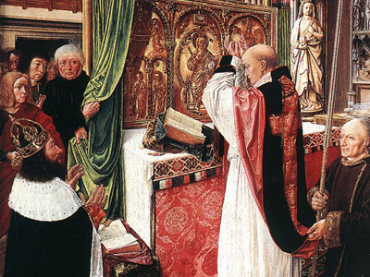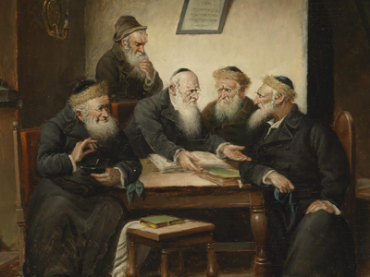Religion
Ar-Raoudat at-tibiyya (Le jardin médical) par Ubaîd-Allah Ben Gibraîl Ben Bakhtichoû
Edited with an Introduction by Paul Sbath
Series: Analecta Gorgiana 668
ISBN: 978-1-61719-618-8
Sbath here publishes the Arabic text of The Medical Garden, a compendium of medical-philosophical definitions, the work of the last prominent member of the famous Bakhtishu‘ family of physicians, with notes and a brief introduction.
$49.00
Note sur l'ouvrage syriaque intitulé Le Jardin des Délices
By J.-B. Chabot
Series: Analecta Gorgiana 669
ISBN: 978-1-61719-619-5
In this short work, originally published in the Festschrift for Nöldeke, Chabot gives a notice and overview of the Gannat Bussame, a commentary on the East Syriac lectionary and an important witness to the East Syriac exegetical tradition.
$35.00
Catholic Catechism in Urmia Aramaic
By Anonymous
Series: Analecta Gorgiana 672
ISBN: 978-1-61719-622-5
This catechism in the Aramaic dialect of Urmia, originally published at the Lazarist Press there, provides questions and answers regarding the Catholic faith in that language.
$52.00
Catholic Catechism in the Mosul Dialect of Aramaic (Sureth)
Petit catéchisme en langue chaldéenne vulgaire
By Anonymous
Series: Analecta Gorgiana 673
ISBN: 978-1-61719-623-2
This is the second printing of a Catholic catechism in the Aramaic dialect of Mosul, originally published at the Dominican Press there.
$40.00
Technologies of Medieval Song
The Lawrence J. Schoenberg Symposium on Manuscript Studies in the Digital Age; 2010 Symposium
Edited by Lynn Ransom & Emma Dillon
ISBN: 978-1-61719-056-8
This volume gathers six essays from papers presented at the 3rd Annual Lawrence J. Schoenberg Symposium on November 19-20, 2010. The essays explore both the technology of inscribed musical expression in the Middle Ages—especially in regard to notation—and the role that modern digital technologies play in facilitating the study of music manuscripts today. As the manuscript evidence shows, medieval music as written text was both expressive and prescriptive in shaping music-making practices, performance, and reception.
$127.00
Praying the Rosary and Hearing the Mass
Méthode facile pour réciter le Très-saint Rosaire
By Anonymous
Series: Analecta Gorgiana 677
ISBN: 978-1-61719-628-7
This manual, in Arabic and originally published at the Dominican Press in Mosul, contains the complete cycle of praying the Rosary, together with a guide for hearing the Mass.
$45.00
An Essay on Engagement and Marriage Contracts according to the Canons of the Roman Church and the Ea
By Joseph David
Series: Analecta Gorgiana 680
ISBN: 978-1-61719-631-7
Clemens Joseph David (1829-1890) here studies the practices and laws of engagement and marriage among Syriac Catholics with an eye to Roman Canon Law on these aspects.
$48.00
Consolidation
An Address Delivered before the Annual Meeting of the English Church Union on June 1st, 1897
Series: Analecta Gorgiana 687
ISBN: 978-1-61719-641-6
The High Church position, as of the Diamond Jubilee: after much turbulence and political interference, can the Bishops, advised by liturgists, reach a Victorian Settlement of the ceremonies of the Church of England?
$32.00
Der Paulinismus und die Logia Jesu
in ihrem gegenseitigen Verhältnis untersucht
By Alfred Resch
ISBN: 978-1-61719-648-5
A classic study of the earlist Christianity, this volume attempts to solve the problem of the relation of Jesus and Paul, by arguing that Paul knew and used the common source of Matthew and Luke.
$246.00
Die Akten der edessenischen Bekenner Gurjas Samonas und Abibos
Edited and Translated by Oscar von Gebhardt; Edited by Ernst von Döbschutz
ISBN: 978-1-61719-650-8
This book presents parallel texts of the Acts of the Three Martyrs of Edessa; the Syriac text is translated into German, Greek, and Latin.
$165.00
The Old Red Sandstone
New Walks in an Old Field
By Hugh Miller
ISBN: 978-1-61719-651-5
One of the first great popular presentations of geology; presents geology as consistent with and supporting revelation.
$133.00
L'Hellénisme et l'Apôtre Paul
By C. Toussaint
Series: Kiraz Theological Archive 65
ISBN: 978-1-61719-663-8
This book examines Paul as a hybrid of both Jewish and early Christian traditions meeting at the crossroads of a commonly-shared Hellenistic culture.
$174.00
Étude sur les Origines des Églises de l'Age apostolique
ISBN: 978-1-61719-664-5
Beginning with the history of the formation of the first Christian churches, this work begins with an extensive source criticism of the text of Acts, a history of the Church of Jerusalem, and the organization and action of Paul's mission to the Gentiles.
$96.00
Le Mouvement Baptiste
en Palestine et Syrie (150 av. J.-C. - 300 ap. J.-C.)
Series: Kiraz Theological Archive 66
ISBN: 978-1-61719-678-2
This book explores baptism in the ancient world, the sects which practiced it, their history, origins, characters, diversity, and influences.
$202.00
Die liturgische Gewandung in Occident und Orient
nach Ursprung und Entwickliung, Verwendung und Symbolik
By Joseph Braun
Series: Kiraz Liturgical Studies 66
ISBN: 978-1-61719-744-4
This volume, written by a Jesuit, discusses the history and use of liturgical garments.
$284.00
The Life of St. Ephrem the Syrian, the Great Teacher of the Syriac Church
By Anonymous
Series: Syriac Studies Library 180
ISBN: 978-1-61719-759-8
This popular presentation of the life of St. Ephrem in sixteen chapters in Arabic, originally printed at the Dominican Press in Mosul, covers Ephrem’s life and activity from his birth. Final chapters touch on his writings and doctrine.
$154.00
The Little Office of the Blessed Virgin Mary
Petit office de la Très-Sainte Vierge
By Anonymous
Series: Syriac Studies Library 182
ISBN: 978-1-61719-761-1
This volume contains the Arabic version of the Little Office of the Blessed Virgin Mary, the shorter form of the Divine Office for the Virgin.
$164.00
A Summary Catechism in Arabic
Abrégé de la doctrine chrétienne
By Anonymous
Series: Syriac Studies Library 183
ISBN: 978-1-61719-762-8
This volume presents a summary catechism in Arabic for young students and includes a number of prayers and an overview of Christian beliefs, duties, and means of sanctification.
$184.00
Code of Jewish Law (Kitzur Schulchan Aruch)
A compilation of Jewish Laws and Customs
By Solomon Ganzfried; Translated by Hyman E. Goldin
Series: Kiraz Jewish Studies Archive 12
ISBN: 978-1-61719-817-5
A guide to, and abbreviation of, the standard code of Jewish law, the Shulhan Aruch
$225.00
Linen Ornaments of the Church
Series: Analecta Gorgiana 701
ISBN: 978-1-61719-820-5
The linen ornaments of the Anglican Cummunion, copiously considered, with plates and drawings.
$37.00
Missions to Muslims
Series: Analecta Gorgiana 703
ISBN: 978-1-61719-822-9
A summary of the difficulties of the conversion of Islam and a seven-point program to overcome them.
$34.00
Islam and its Need
By W. Norman Leak; Preface by Samuel Marinus Zwemer
Series: Analecta Gorgiana 704
ISBN: 978-1-61719-823-6
Leak provides a survey of Islam, and its relations to Christendom. His work involves the history, distribution, doctrines, and practice of Islam, and argues that the utter unlikeness of Allah is equivalent to agnosticism.
$40.00
Perspectives on Hebrew Scriptures VI
Comprising the Contents of Journal of Hebrew Scriptures, Vol. 9
Edited by Ehud Ben Zvi
ISBN: 978-1-61143-004-2
This volume incorporates all the articles and reviews published in Volume 9 (2009) of the Journal of Hebrew Scriptures.
$321.00
Selected Papers Presented to the Asia Pacific Early Christian Studies Society
Fifth Annual Conference (Sendai, Japan, September 10–12, 2009) and other Patristic Studies
ISBN: 978-1-61143-005-9
The volume collects selected papers from the fifth annual APECSS conference which focused on the topic of letters from Christian Antiquity. The conference papers deal with epistolography from the apostle Paul up to Theodore the Studite (ninth century), considered in different aspects, namely, historiography of studies, literary form, Church history, dogmatic contents, attribution, etc. Other patristic studies include hagiography, liturgics, Christian art, early Egyptian monasticism, Islamic-Christian relations in the Middle Ages, and the Jewish background of Christianity.
$195.00
From Anglo-First-Wave towards American Second-Wave Jewish Feminism
Negotiating with Jewish Feminist Theology and its Communities in the Writing of Amy Levy
By Luke Devine
Series: Judaism in Context 9
ISBN: 978-1-61719-915-8
This book completely redefines our understanding of fin de siècle Anglo-Jewish author Amy Levy and her writing. Demonstrating that Levy’s writing is less anti-Judaic and more profoundly influenced by the religious concerns of classical German Reformism, Luke Devine's innovative approach reveals that Levy's writing constitutes a genre whose female subjectivity evinces a concern for justice and authority that prefigures numerous aspects of Second-Wave Jewish feminist theory and its spiritual and theological underpinnings.
$185.00
Filter by
Filter by price
Filter by manufacturer



























